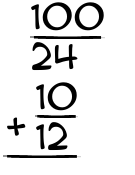What is 100/24 + 10/12?

|
This is how to add
|
||||||||||||||||||||||||||||||||||||||||
Step 1We have to make sure the denominators are equal. Since 12 is evenly divided by 24, we can multiply just one term to get a common denominator. Multiply 10 by 2, and get 20, then we multiply 12 by 2 and get 24. The problem now has new fractions to add:
|
||||||||||||||||||||||||||||||||||||||||
Step 2Since our denominators match, we can add the numerators. 100 + 20 = 120 This yields the answer
|
||||||||||||||||||||||||||||||||||||||||
Step 3The last step is to reduce the fraction if we can. To find out, we try dividing it by 2... Are both the numerator and the denominator evenly divisible by 2? Yes! So we reduce it:
So far so good... let's try to divide by that number again. Are both the numerator and the denominator evenly divisible by 2? Yes! So we reduce it:
So far so good... let's try to divide by that number again. Are both the numerator and the denominator evenly divisible by 2? Yes! So we reduce it:
So far so good... let's try to divide by that number again. No good. So next you try the next prime number, which is 3... Are both the numerator and the denominator evenly divisible by 3? Yes! So we reduce it:
So far so good... let's try to divide by that number again. No good. 3 is larger than 1. So we're done reducing. And we're done! Here's the final answer to 100/24 + 10/12
|